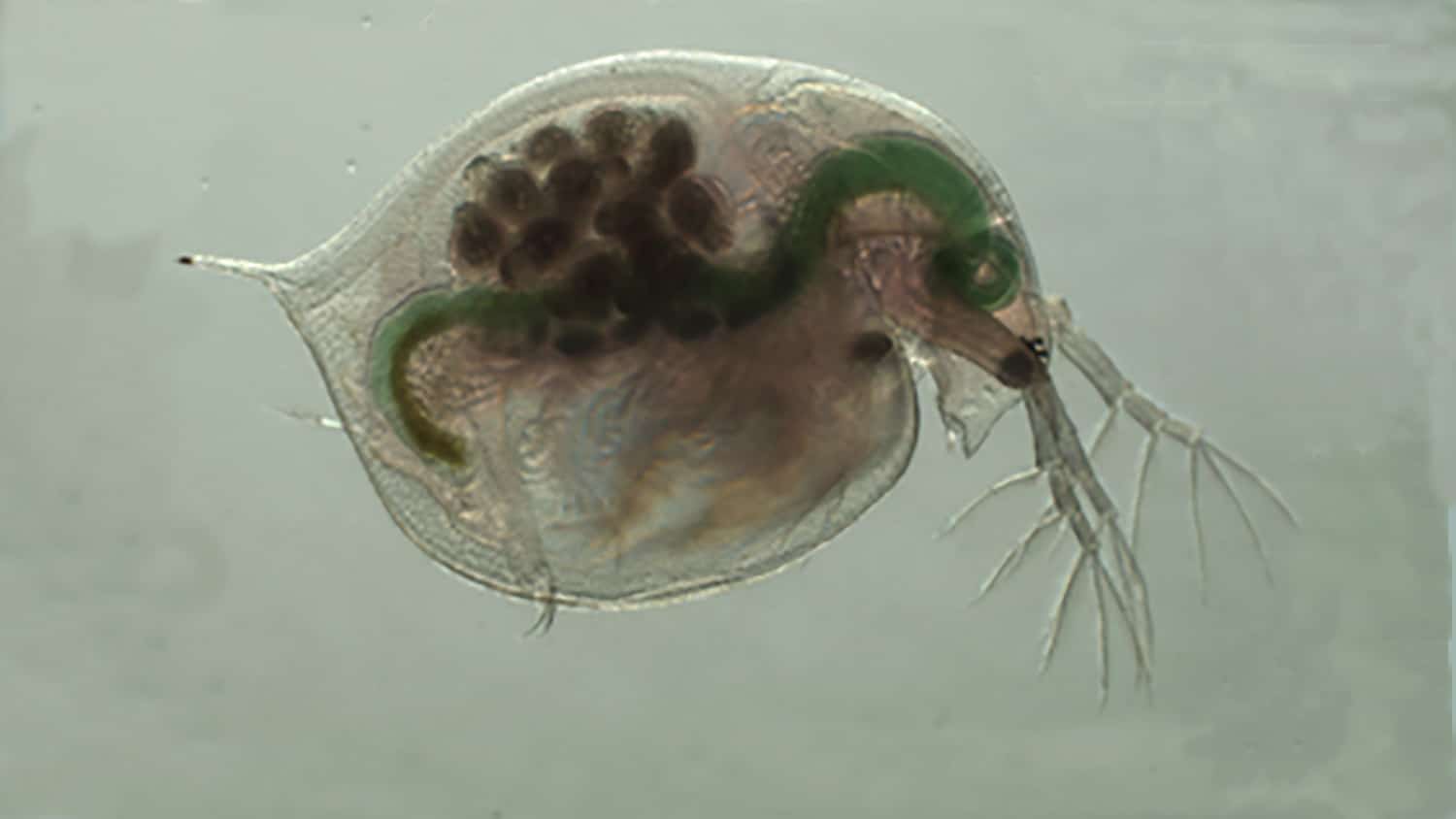Disrupting Key Protein Alters Biological Rhythms in Water Flea

Researchers from North Carolina State University have shown that the E75 protein is a key regulator of some biological rhythms through interactions with nitric oxide. Suppression of E75 results in longer molt cycles and reduced numbers of offspring in the water flea, Daphnia magna. The work also raises questions about the ability of nitric oxide from environmental sources to disrupt biological rhythms that are critical to population sustainability.
Gerald LeBlanc, professor of biology at NC State and corresponding author of a paper describing the work, was interested in the role that environmental cues played in regulating biological rhythms using Daphnia magna as a model organism.
Daphnia magna, or the common water flea, is a crustacean found in most freshwater ponds in North America. The water flea is not only a keystone species – important for the maintenance of food webs in these ecosystems – it is also a lab model for crustaceans more generally.
“We are looking at how biological rhythms regulate physiological processes,” LeBlanc says. “How does an organism know when to molt? Or when to migrate? Many rhythms are based on environmental cues; for example, our own circadian – or sleep cycle – is based in part on experiencing light and dark. But are there similar environmental cues that regulate longer rhythms – and if so, what effect might environmental stressors have on them?”
LeBlanc and his team targeted a protein, E75, known to play a role in regulating some biological rhythms. Nitric oxide, a short-lived hormone and potent signaling molecule, inhibits E75’s activity. The researchers exposed daphnids to the nitric oxide-generating compound sodium nitroprusside, which disrupted the molecular cascade that leads to molting and increased the length of the molt cycle. They then established that direct suppression of E75 using RNA interference produced similar results. Not only did suppression of E75 lengthen the molt cycle but it also reduced the number of offspring produced.
“Water fleas produce nitric oxide naturally,” LeBlanc says, “but they can also take up nitrogenous compounds from their surroundings and convert them into nitric oxide. E75 is the first domino in the molt cycle, and a critical regulator of molting and reproduction, since they are coordinated in water flea. We show that nitric oxide can disrupt the rhythm, thereby disrupting growth, time to reproductive maturation and fecundity. The consequences of such a disruption over time could be devastating to the population.
“We also know that the molt cycle is regulated by environmental cues. It is possible that nitric oxide is the environmental modulator, in which case environmental sources of nitrogen – such as fertilizer runoff – could fool the animal and disrupt the population. These are questions we would like to explore in the future.”
The work appears in PLOS ONE and is supported by the National Science Foundation (grant IOS-1350998). Former NC State doctoral students Stephanie Street and Stephanie Eytcheson contributed to this work as part of their dissertation research.
-peake-
Note to editors: An abstract of the paper follows.
“The role of nuclear receptor E75 in regulating the molt cycle of Daphnia magna and consequences of its disruption”
DOI: 10.1371/journal.pone.0221642
Authors: Stephanie Street, Stephanie Eytcheson, Gerald LeBlanc, North Carolina State University
Published: Aug. 27, 2019 in PLOS ONE
Abstract:
Biological rhythms regulate innumerable physiological processes, yet little is known of factors that regulate many of these rhythms. Disruption in the timing of these rhythms can have devastating impacts on population sustainability. We hypothesized that the timing of the molt infradian rhythm in the crustacean Daphnia magna is regulated by the joint action of the protein E75 and nitric oxide. Further, we hypothesized that disruption of the function of E75 would adversely impact several physiological processes related to growth and reproduction. Analysis of mRNA levels of several genes, involved in regulating the molt cycle in insects, revealed the sequential accumulation of E75, its dimer partner HR3, FTZ-F1, and CYP18a1 during the molt cycle. Exposure to the nitric oxide donor sodium nitroprusside early in the molt cycle had no effect on E75 or HR3 mRNA levels, but delayed the peak accumulation of FTZ-F1 and CYP18a1 mRNA. The subsequent exuviation was also delayed consistent with the delay in peak accumulation of FTZ-F1 and CYP18a1. These results supported our assertion that nitric oxide binds E75 rendering it incapable of binding HR3. Excess HR3 protein then enhanced the accumulation of the downstream products FTZ-F1 and CYP18a1. Similarly, suppression of E75 mRNA levels, using siRNA, had no effect on mRNA levels of HR3 but elevated mRNA levels of FTZ-F1. Consistent with these molecular responses, the suppression of E75 using siRNA increased the duration of the molt cycle and reduced the number of offspring produced. We conclude that the molt cycle of daphnids is regulated in a manner similar to insects and disruption of E75 results in a lengthening of the molt cycle and a reduction the release of viable offspring.
This post was originally published in NC State News.


